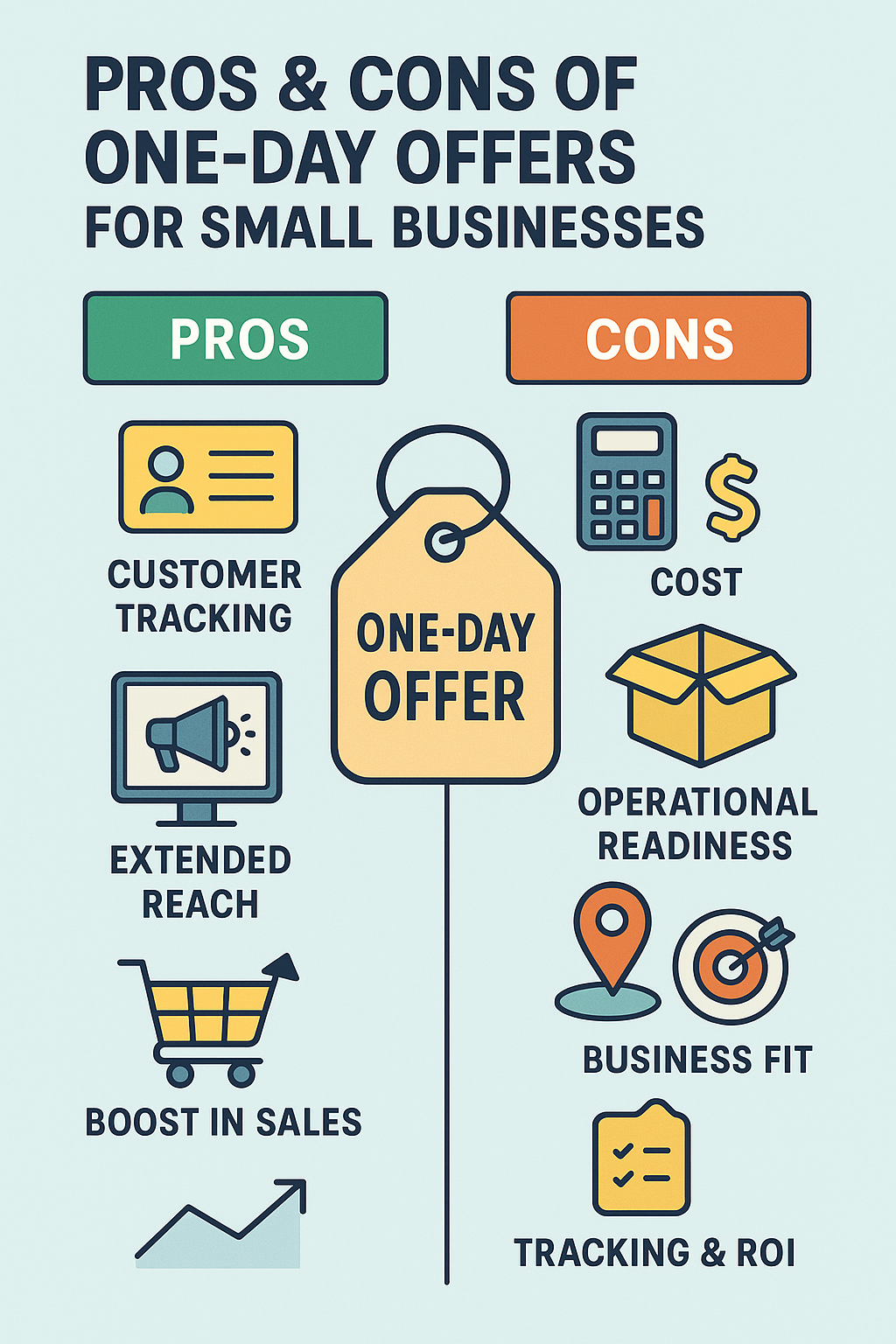Back in the late 2000s, “one-day offer” and “daily deal” sites like Groupon and LivingSocial exploded in popularity. They promised small businesses the chance to get massive exposure overnight by offering deep discounts for a limited time. Even today, although the hype has cooled, the core idea of flash sales and time-limited promotions is alive and thriving — not just on deal sites, but also across e-commerce platforms, social media, and even email marketing.
So, are these types of promotions still worth it for small businesses? Let’s explore the pros, cons, and how to make them work in today’s market.
Advantages of One-Day Offers
1. Customer Tracking and Remarketing
The real gold isn’t just the first purchase — it’s the customer data. Many deal platforms give you access to the list of buyers, allowing you to nurture those leads with follow-up offers, newsletters, or loyalty programs.
-
Stat update: While original studies showed 40–50% of deal users returned to the business, today’s trend is that customers are far more likely to return if you give them a reason — like a loyalty perk, personalized email, or social follow-up.
2. Extended Reach and Brand Exposure
One-day offers instantly plug your product or service into the deal platform’s huge audience base. For a small business, that kind of reach could take years to build on your own.
-
Modern twist: Many consumers now expect deals to show up in their Instagram feed, TikTok shop, or Amazon “Today’s Deals.” A time-limited offer can introduce your brand to new audiences who might never have found you otherwise.
3. Boost in Sales and Upselling Potential
Flash deals often bring people in for the bargain — but smart businesses turn bargain hunters into big spenders.
-
A customer may buy your discounted product, but once they’re in your store (or on your site), they often purchase add-ons or upgrades.
-
You can design the offer so it funnels customers toward premium products or services.
Key Factors to Consider
1. Cost and Profitability
Deep discounts + platform fees = a margin squeeze. Groupon still charges commissions between 30–50%, and competitors are similar. Before jumping in, run the numbers carefully.
-
Ask yourself: Am I willing to lose money on the first sale if I gain a long-term customer?
-
Flash deals can work as a customer acquisition cost (CAC) — but only if you have a clear plan to retain those customers.
2. Operational Readiness
Can you handle the surge? A sudden wave of customers can overwhelm your stock, website, or customer support team.
-
Pro tip: Cap the number of deals you offer. Instead of unlimited vouchers, sell 100 and stop. That way you can manage demand while keeping it exclusive.
3. Business Fit
Not every business is a good match.
-
Local restaurants, spas, and gyms often thrive on deal sites.
-
Niche or luxury businesses may struggle because discount-hunters aren’t always the right audience.
-
Always check the platform’s audience demographics before signing up.
4. Tracking and ROI
What you don’t measure, you can’t improve. Make sure you have a system in place to track:
-
How many first-time buyers convert to repeat customers.
-
How much extra (upsell, cross-sell, add-ons) those customers spend.
-
The cost vs. lifetime value (LTV) of each acquired customer.
If the site doesn’t provide buyer data, build your own system — for example, by requiring customers to redeem the voucher through your website or loyalty app.
Modern Alternatives to Traditional Deal Sites
Even though Groupon-style sites aren’t as hot as they once were, the one-day offer strategy is alive and well in new forms:
-
Amazon Lightning Deals and Prime Day promos for e-commerce sellers.
-
Instagram & TikTok flash sales with countdown timers.
-
Email list exclusives — “24-Hour VIP Sale” to reward subscribers.
-
Shopify apps that let you add daily deal countdowns to your store.
In other words: You don’t need Groupon to run a one-day offer anymore. You can build the urgency directly into your own marketing.
Final Thoughts
One-day offer sites (and their modern cousins) can still be a powerful marketing tool for small businesses. But the real winners are those who see them not as a one-off cash grab, but as a strategic customer acquisition play.
Test small, measure everything, and focus on converting deal hunters into loyal fans. When done right, one-day offers can move from being a gamble to being one of the smartest arrows in your marketing quiver.


Leave a Reply